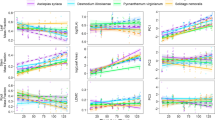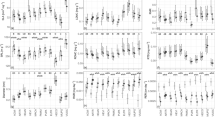Summary
The time at which plants emerge from the soil is shown to be correlated with both survival and growth in each of four years in a plant community emerging after yearly plowing. For all seven species investigated, earlier emerging individuals generally had both a higher biomass and probability of survival. There were differences among species in the effect of emergence time on biomass, with the growth of upright, annual species being more suppressed by later emergence than the growth of other species. No significant differences were found among species in the effects of emergence time on survival. It was expected that differences among species in the effect of emergence time on fitness might lead to a correlation between the patterns of emergence time and species characteristics such as growth form or lifespan. Mean emergence times did vary significantly among both the seven species and the four years of the study. However, there was no correlation between emergence time and species lifespan, growth form, abundance, or competitive ability. The lack of a correlation between the selection pressure on species and their emergence time could be due low heritability, insufficient time for selection and evolution, and/or selection on correlated characters.
Similar content being viewed by others
References
Arthur AE, Gale JS, Lawrence KJ (1973) Variation in wild populations of Papaver dubium. VII. Germination time. Heredity 30:189–197
Cook RE (1979) Patterns of juvenile mortality and recruitment in plants. In: Solbrig O, Jain S, Johnson g, Raven P (eds) Topics in plant population biology, Columbia University Press, New York, pp 207–231
Downing JA (1979) Aggregation, transformation, and the design of benthos sampling programs. J Fish Res Board Can 36:1454–1463
Falconer DS (1981) Introduction to quantitative genetics. Longman, London
Gross KL (1980) Colonization by Verbascum thapsus (Mullein) of an oldfield in Michigan: experiments on the effects of vegetation. J Ecol 68:919–927
Harper JL (1977) Population biology of plants. Academic Press, London
Howell N (1981) The effect of seed size and relative emergence time on fitness in a natural population of Impatiens capensis Meerb. (Balsaminaceae). Am Midl Natur 105:312–320
Kalisz S (1986) Variable selection on the timing of germination in Collinsia verna (Scrophulariaceae). Evolution 40:479–491
Lande R, Arnold SJ (1983) The measurement of selection on correlated characters. Evolution 37:1210–1226
Miller TE, Werner PA (1987) Competitive effects and responses between plant species in a first-year old-field community. Ecology (in press)
Naylor JM, Jana S (1976) Genetic adaptation for seed dormancy in Avena fatua. Can J Bot 54:306–312
Newman EI (1961) Population studies on winter annuals in the breckland. Ph D thesis, Cambridge University
Parrish JD, Bazzaz FA (1976) Underground niche separation in successional plants. Ecology 57:1281–1288
Roach DA (1986) Timing of seed production and dispersal in Geranium carolinianum: effects on fitness. Ecology 67:572–576
Ross MA, Harper JL (1972) Occupation of biological space during seedling establishment. J Ecol 60:77–88
Silvertown JW (1981) Seed size, life span, and germination date as coadapted features of plant life history. Am Nat 118:860–864
Soetono, Donald CM (1980) Emergence, growth, and dominance in drilled and square-planted barley crops. Aust J Agric Res 31:455–470
Sokal RR, Rohlf FJ (1981) Biometry. Freeman, New York
Stanton M (1985) Seed size and emergence time within a stand of wild radish (Raphanus raphanistrum L.): the establishment of a fitness hierarchy. Oecologia (Berlin) 67:524–531
Venable DL (1984) Using intraspecific variation to study the ecological significance and evolution of plant life-histories. In: Dirzo R, Sarukhan J (eds) Perspectives on plant population ecology, Sinauer, Sunderland, pp 166–187
Veresoglou DS, Fitter AH (1984) Spatial and temporal patterns of growth and nutrient uptake of five coexisting grass. J Ecol 72:259–272
Watkinson AR (1981) The population ecology of winter annuals. In: Synge H (ed) The biological aspects of rare plant conservation. Wiley, Chichester, pp 253–264
Winsor JA (1981) Germination and establishment in Impatiens capensis: Adaptations to interspecific competition. Ph D dissertation, University of Michigan
Author information
Authors and Affiliations
Rights and permissions
About this article
Cite this article
Miller, T.E. Effects of emergence time on survival and growth in an early old-field plant community. Oecologia 72, 272–278 (1987). https://doi.org/10.1007/BF00379278
Received:
Issue Date:
DOI: https://doi.org/10.1007/BF00379278




